What fitness equipment does the gym have? What is the effect of each?
As a fitness enthusiast who has been in the gym for three years, I have personally used more than 100 kinds of equipment. So today I will introduce some frequently used instruments to you systematically. These are all zero-based beginners who can start training directly . A super guide to this 74 gym machines including 12 free weight machines, 9 special free weight machines, 15 free weight assist machines, 7 original fitness machines, 7 body machines and 24 stationary machines!
1. Free force equipment (12 types)
A free-force machine is a machine that can be moved in any way, in any direction.
Barbell: A combination of bars and plates. The length is 1.5~2.1 meters, divided into 7 types:

1. Olympic barbell : A barbell used for weightlifting and powerlifting (bench press, squat, deadlift) competitions, common in gyms. The weight is 20kg and the length is 2.1 meters (right in the picture below). The diameter of the two ends of the bar (hanging the barbell plate) is 5cm, and the diameter of the middle of the bar (hand grip) is 2.5cm. The grip part of the rod has raised lines for easy grip.
2. Standard barbell : Similar to the Olympic barbell, the diameter of the middle of the bar is 2.5cm, and the grip part has raised lines. But the diameter of both ends of the rod is only 2.5cm (right of the picture below).

3. Fixed barbell: The barbell with the barbell plate added.

4. EZ curl bar: Some parts of the bar are curved. This barbell reduces the amount of dumbbells on the user's wrist. The long head (outside) of the biceps is more stimulated when the user performs a barbell curl with a curved bar.

5. Fat bar: A barbell with a larger diameter (thicker) grip portion. The diameter of the grip portion of a regular barbell is 2.5cm, while the diameter of the grip portion of a thick barbell is 5-8cm. Train with this barbell to develop a stronger grip. However, deadlifting, rowing, and other pull-ups with this bar will affect muscle strength and size gains (because the weights used will be lighter).

6. Safety squat bar: A barbell used for squatting with 2 handles that are perpendicular to the bar. When performing a squat, the user can hold the handle for increased safety.
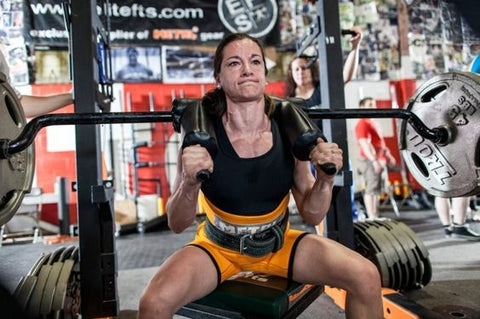
7. Trap bar: A bar with a hexagonal shape in the middle. To perform the exercise, the user stands inside the barbell and holds the handle. This barbell is often used for shrugs or deadlifts.

Weight plates : iron plates (in fact, commonly known as barbell plates) hanging on barbells or fitness equipment, ranging in weight from 0.5kg to 20kg, are divided into 3 types:
1. Olympic weight plates: The hole in the middle has a diameter of 5.4cm and is used for Olympic weight plates.
2. Standard weight plate: The hole in the middle has a diameter of 3cm and is used for standard weight plates.
3. Bumper plates: a kind of Olympic barbell plate, the outer edge is rubber, which can reduce the impact force on the ground after the barbell falls.
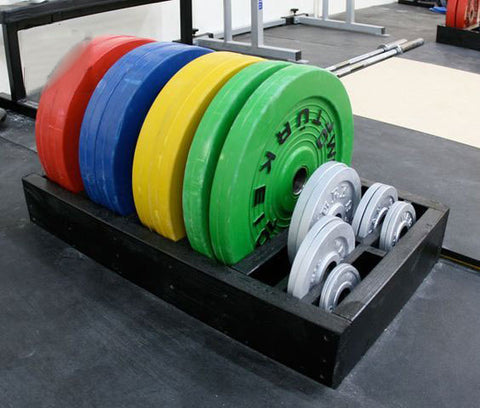
Collar : Clips to the bar to stabilize the plate.
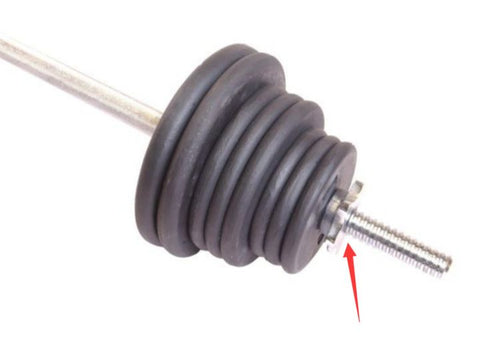
Dumbbell : Everyone on earth knows it! The length is 20-30cm, and the length of the grip part is usually 15cm. There are 2 types: one is fixed weight, the total weight is adjustable (removable).
2. Special free force equipment (9 types)
1. Medicine ball : Leather or rubber material. Different sizes, different weights. Medicine balls are often used for throwing exercises, or occasionally in place of barbell or dumbbell exercises.

2. Kettlebell : The weight ranges from 7kg to 23kg (common), mainly used for swing and clean and jerk exercises. The picture below shows the one-arm kettlebell swing.
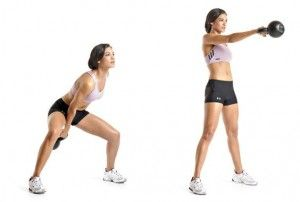
3. Head harness : The picture below is usually used for neck exercises to strengthen the neck muscles.

4. Weighted belt : A belt with barbell plates attached to it. You can increase resistance when performing movements like dips and pull-ups.

5. Weight vest : a vest with a total weight of about 1-18kg. When doing freehand exercises, you can add resistance, such as push-ups. Can also be used while running.

6. Sand bags : This one needs no introduction. Everyone on earth knows that it can be tied on the legs and other parts to increase resistance.
7. Wrist roller : It is mainly used to exercise the forearm muscles. The user turns the handle until the dumbbell plate moves to the highest position. Rolling from the bottom to the top works the arm flexors, and rolling from the top to the bottom works the arm extensors.

8. Arm blaster : used when performing barbell curls, it can prevent the upper arm from moving and improve the exercise effect.


9. Land mine : one end is fixed, and one end is placed with a barbell, which can perform a variety of training movements and exercise the muscles of various parts of the body.


3. Free power assistive devices (15 types)
Weight benches : Seats used with free weights, divided into 9 types
1. Bench-press bench: usually used in barbell bench press, horizontal bench.

2. Incline bench-press bench: The angle to the ground is 35-45 degrees, usually used for incline barbell bench press.

3. Decline bench-press bench: The angle is 30-40 degrees from the ground, with the head facing down, and is usually used to perform the downward barbell bench press.

4. Shoulder press bench: The backrest is perpendicular to the ground and is used for barbell presses.

5. Preacher bench: The bench is horizontal, with the armrests at 45 degrees to the ground, directly in front of the user, for barbell curls.

6. Flat bench: a horizontal chair that can sit or lie down.

7. Adjustable-incline bench: The angle of the backrest can be adjusted from horizontal to vertical.

8. Adjustable-decline bench: The angle of the backrest can be adjusted, and it is usually used for chest and abdominal training.
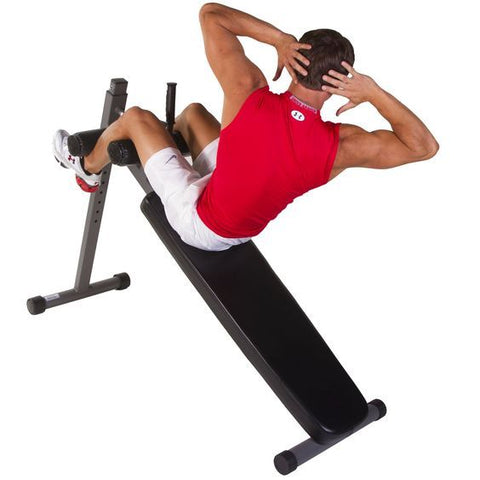
9. Low-back bench: The seat is short and horizontal, with the backrest perpendicular to the ground, usually used for dumbbell or barbell presses, triceps arm flexion and extension, etc.

Weight rack : A rack for placing barbells, divided into two types:
1. Power rack: A multifunctional training rack with safety bars on both sides to protect the trainer's safety. It is often used for squats, shrugs, and presses.

2. Squat rack: Similar to a power rack.

Stability objects: Devices used to improve the strength and stability of the user's core area (waist and abdomen), divided into 4 categories:
1. Exercise ball: Also called stability ball, it varies in size. The user can sit or lie on it, perform dumbbell or barbell movements, as well as perform crunches and push-ups.

2. BOSU balance trainer: The top is semi-circular, which can be used to practice various movements.

3. Stability disc: A small piece of equipment on which the user can stand or sit for strength training.

4. Balance board: wooden, can be used for various exercises.

4. Original fitness equipment (7 kinds)
Before the advent of barbells and dumbbells, people used primitive fitness equipment such as stones or sandbags to exercise. Although these equipments are clumsy and ancient, they can better exercise the user's functional strength .
Strong man fitness equipment: The training equipment used by the strong man to participate in the strong man competition is mainly divided into 3 types:
1. Atlas stone: A huge heavy stone made of granite or concrete, specially used for strongman competitions. The diameter is 36-152cm and the weight is 64-136kg. How to use? Just watch the Hercules game!

2. Logs: dedicated to the Hercules competition, with a weight of 91-136kg. Competitors need to lift the log over their heads.

3. Tractor tires : Special for the Hercules competition, ranging in weight from 227kg to 408kg.

Training Auxiliary Equipment : Powerful fitness equipment used to enhance strength, mainly divided into 2 types:
1. Chains: Can be used in conjunction with barbells to provide continuous resistance for exercisers, such as squats or bench presses. When the bodybuilder lifts the bar from the bottom, the resistance caused by the chain will increase, and the further away from the ground, the greater the resistance.

2. Beer keg: An empty beer keg weighs 14kg. Some athletes in football, basketball or other fields use it to improve functional strength.

Daily fitness equipment : basically every household has them, mainly including the following two:
1. Cans: Lightweight and shaped like dumbbells. When there are no dumbbells at home, they can be used instead of dumbbells, especially suitable for weaker whites to perform high-rep strength training.

2. Jugs: Similar in function to cans, they are heavier than cans and can be filled with water or sand. I won't post a picture, everyone on earth knows what a kettle is.
5. Human body equipment (7 kinds)
The human body itself is a kind of equipment, and our own body weight is the resistance when doing freehand training.
Self-weight : Exercises performed alone with self-weight as resistance, such as push-ups, pull-ups, parallel bars, squats, abdominal crunches, etc.

Other people's weight : Training with other people's weight as resistance, as shown below, Dr. Jim Stoppani treats this girl as a dumbbell or barbell.

Freehand auxiliary equipment : equipment that helps trainers perform freehand training (using their own body weight as resistance), mainly including the following 5 types:
1. Chin-up bar: Everyone on earth knows it, needless to say. But not many people can do a standard pull-up these days.

2. Parallel bars: Mainly used for parallel bars, arm flexion and extension, leg raising and other actions. Nice piece of equipment, but not many people use it anymore (power level is worrying).

3. Vertical bench: It is mainly used for leg raising (exercise the abdomen, and the back is close to the back). Some vertical chairs have handles for parallel bars, which can be used in place of parallel bars.

4. Back extension bench: It is used for back extension. It is forbidden for people with lower back injuries!

5. TRX: Suspension training rope, which can be used to perform a variety of exercises. Invented by poster commando Randy Hetrick in 1990.
6. Fixtures (24 kinds)
Linear guiding device: The so-called linear guiding device, in layman's terms, refers to a fixed device that only allows you to perform (fixed) linear motion, mainly including the following three types:
1. Smith machine: One of the most common stationary equipment in the gym, which allows users to perform a variety of training movements, such as bench press, squat, rowing, etc. Smith machines are limited to linear movements. Smith machines are safer than free force machines.

2. Leg press: It is mainly used for leg press training. In addition, it can also be used for exercises on the buttocks and other parts.

3. Hack squat: Similar to the leg press, the bodybuilder uses it in a standing position (back against the back).

Gym pulley system :As the name suggests, rope and pulley-based fitness machines(Gym pulley system). Unlike linear guided machines, Gym pulley system allow the user to perform multi-directional movements.
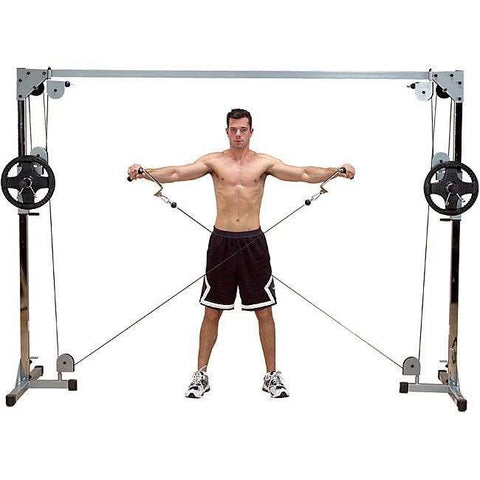
1. Carabiner: connects the rope and the training bar;

2. Lat bar: mainly used to practice the latissimus dorsi (high pull-down) and other back training movements, as shown in the figure below;

3. Parallel-arm lat bar: used for back training movements such as high pull-downs or rope rowing, above and below;


4. EZ bar: It can reduce the pressure on the wrist and can be used for rope curling and other actions;

5. Short straight bar: can be used for triceps presses, biceps curls, etc.;

6. Low row bar: mainly used for rope rowing and other actions;


7. Single-handle D-grip: A single-hand grip, which can be used to perform unilateral training movements such as one-handed curling, one-handed rowing, etc., and can also be used to perform actions such as rope clamping .


8. Pressdown bar: mainly used for rope pressing action;

9. Rope: can be used to perform a variety of exercises, such as triceps press, hammer curl, etc.;

10. Ankle collar: It is tied to the ankle and used for back leg lifts, leg curls and other actions.

Other fixed devices
1. Leg flexor: used for leg flexion and extension;

2. Leg curler: used to perform leg curls, there are two types of prone and sitting;
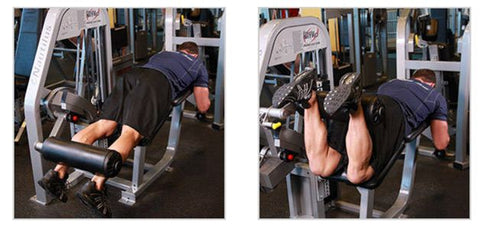

3. Incline chest presser: used to perform incline chest presses;

4. Sitting chest clamp: used for seated chest clamping action;

5. Abdominal cruncher: used for crunching action;
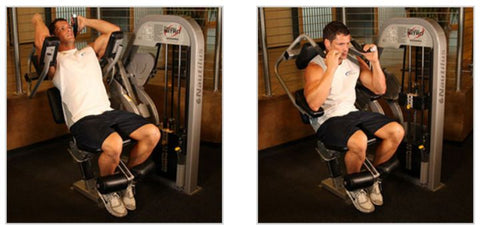
6. Parallel bar flexor: imitate parallel bar flexion and extension;

7. High position rowing machine: used for high position rowing action;

8. Seated rowing machine: used for seated rowing action;

The pictures are from the Internet, from Dr. Zhang Jingqi
9. Seated press: used for seated shoulder press;

10. Priest bench curler: used to perform priest bench curling movements;

11. Decline chest press: used to perform the downward chest press.







